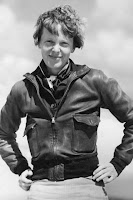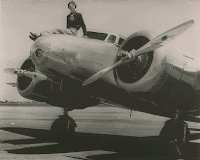 |
| Earhart in the cockpit of her Electra |
Note: this is an updated version of a previous entry from 2012.
Efforts have long been underway to find the remnants of Amelia Earhart's plane, along with remains, or at least, evidence that she survived the crash on a small atoll in the south Pacific. Recent evidence has trickled up from the bowels of classified US archives. The
History Channel will air a special at 9/8c on 9 July 2017. It will review the evidence shedding a shocking revelation that Earhart's fate may not have been what we thought.
But just who was Amelia Earhart? Why was her disappearance such a blow to the American public? Perhaps it was because she embodied the damsel in distress, despite being the bold, nonchalant tomboy that she was. Her whole brand was wrapped up and packaged in a fearless, freckle faced pioneer. Her story is haunting because her final fate, while widely speculated, is still fully unknown—and despite the narrowing of
modern searches and tedious review of evidence. Her brand is one of tragedy rather than epic disaster like the
Titanic.
Amelia Earhart is a
mystery. And for that she remains in our memory—nagging us to leave a light on in the window with a candle of hope burning in our collective psyche.
Earhart caught the flying bug when she 10-years old. It was during a stunt-flying exhibition sometime around 1907, a moment when she stood fast as a pilot plunged his plane right at her. "I did not understand [the feeling] at the time," she said, "but I believe that little red airplane said something to me as it swished by." Her first flight wouldn't happen for over a decade. Pilot Frank Hawks took her up in 1920. Once two or three hundred feet off the ground, Earhart knew she had to fly, but it would take yet more time and effort, mixed with some luck, before she would take the stick. Convention of the day wasn't big on women pilots.
However, Earhart didn't hold with convention. She was a tree climbing, belly-slamming sledder and rat hunter, completely used to shocking the knickers off her contemporaries. Most certainly she had her sights set on plowing new ground for women because she kept a scrapbook of newspaper clippings about successful women in male-oriented fields. Even more endearing is that Earhart never shirked her civic or humanitarian duties. During WWI, she left college in her sophomore year (c 1917) to work as a nurse's aide. And she later became a social worker in Boston.

But about a year after that first rush from that flight with Hawks, Earhart took a flying lesson. Six months after that, she had saved enough money to buy her first plane—a second-hand Kinner Airster biplane that was painted bright yellow. Naming it "Canary," Earhart used it to set her first women's record by reaching an altitude of 14,000 feet. And in 1923 she became only the 16th woman to earn a pilot license.
Earhart's early flying efforts did not blanket her with glamour. In fact they were quite the reverse. Conditions for a woman in the early days of flying were less than luxurious or convenient, and the training was hard work. Still, this is where Earhart began her branding transformation. Very aware that male aviators would judge her, she began to cultivate her look with a simple act of sleeping in a brand new leather jacket to give it some wear. She also short-cropped her hair like other
female flyers.
 |
| Amelia Earhart |
Things got tough for Earhart's career in 1923. Her family fortune had been lost, so she worked in jobs outside her preferred career to earn a living and save money. She managed to stay involved in aviation, but nothing significant. Then, on a spring afternoon in 1928, Earhart got a call from George P. Putnam. His simple question was if she'd like to be the first woman to fly the Atlantic. Earhart's answer was equally simple and succinct. "Yes!"
Putnam hooked her up with pilot Wilmer "Bill" Stultz and co-pilot/mechanic Louis E. "Slim" Gordon. And the team flew a Fokker F7 from Newfoundland to Wales in June of 1928. It was a 21-hour flight. And as a publisher and publicist, Putnam was in a position to generate press for Earhart, making her a star. The landmark flight to Wales made headlines worldwide. Three women had died on previous attempts to be that first woman. So on their return to the United States, the team was received with a ticker-tape parade in New York and a reception held by President Calvin Coolidge at the White House.
The trip might seem like no big deal now. Dozens of flights depart each day around the world for destinations 21 hours away. But remember that when Earhart and the team made this flight, the Wright Brothers had only first pushed the Kitty Hawk aloft just 25 years earlier.
All the fanfare launched Earhart into the limelight and she became an instant celebrity. Endorsement deals rolled in and earned more than enough money to fund her flying. It also opened the door to her teaming up with the likes of Charles Lindbergh to promote commercial air travel, a ground floor opportunity for investment in a developing TWA, and to serving as VP of what would become Northeast Airlines
The stars aligned for Earhart and her career took off. She became the first woman, and only the second person, to solo across the Atlantic. Lindbergh was the first. She was awarded the Distinguished Flying Cross, and broke major ground for women in her field. From there, she cruised into the history books by
breaking records all along the way. But it was where she was headed next that sealed her immortal fate in the public heart.
 |
| Earhart with her Lockheed Electra. |
Earhart wanted to be the first woman to fly around the world. Period. She had tried once before and tore up her signature plane, the twin engine Lockheed Electra. Earhart said of this effort, "I have a feeling that there is just about one more good flight left in my system, and I hope this trip is it." On June 1st, in her rebuilt Electra, she and navigator Fred Noonan left Miami on the first leg of a 29,000-mile air trek. Within a month they had 22,000 behind them, and the world was watching. Most people never knew that bad maps dogged the navigation effort for Noonan. That made the next leg even trickier. It was Howland Island—a sliver of dry land on the Pacific Ocean about a mile and a half long and a half-mile wide.
After eight hours in the air, the Earhart team was frantically looking for their target. One of her final transmissions to a US Coast Guard ship tracking her was, "We must be on you, but we cannot see you. Fuel is running low. Been unable to reach you by radio. We are flying at 1,000 feet." After 8:45 pm on 2 July 1937, nothing more.
Silence.
The world loved her for her audacity to attempt what few, if any women or even men had dared. She courted danger with a quiet resolve and a forced smile. She wasn't into the publicity, but it came with her achievements, and her ties to Putnam. Suddenly Amelia was gone—but where? What happened and why? Even after an exhaustive $4 million dollar and 250,000 square mile search, there was no trace, nothing but a sudden emptiness that drives our continued longing for
Amelia Earhart.
___
Side Bar: Amelia was the most famous, but there other women who pierced the fog of early women's flying successes. Follow the links below to get introduced to them.
Bessie Coleman
Matilde E. Moisant
Harriet Quimby
So many more...

 Follow on Instagram
Follow on Instagram




